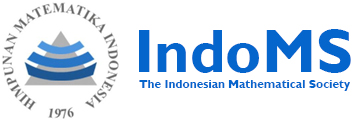Finding The Shortest Route Between East Oku's Islamic Boarding Schools Using The Dijkstra Algorithm
 PDF Download: 81
PDF Download: 81
DOI:
https://doi.org/10.32665/james.v8i2.5265Keywords:
Dijkstra Algorithm, Shortest Path, GraphAbstract
This study aims to measure the distance between Islamic boarding schools in East Oku, using the Dijkstra Algorithm method to make it easier to determine the shortest route from the point of the Nurul Huda Sukaraja Islamic Boarding School to the Subulussalam Sriwangi Islamic Boarding School. In previous research, namely determining the shortest route when distributing from vegetable gardens to warehouses between toll and non-toll routes to minimize costs. In graph theory, the Dijkstra algorithm efficiently calculates the shortest path between any pair of nodes in a weighted graph, both positive and negative. This algorithm works with the principle of dynamic programming and can overcome graphs with a negative weight as long as there are no negative cycles. In its implementation, the Dijkstra algorithm iteratively updates the shortest distance between nodes by directly comparing paths with paths passing through other nodes. The advantage of this algorithm lies in its simplicity and ability to calculate the shortest distance between all pairs of nodes in a single process. The study results show that the Dijkstra Algorithm can show the fastest and most efficient alternative routes compared to conventional routes. Calculations using the Dijkstra Algorithm method produce the shortest trajectory starting from point 1-4-5 with a distance of 48 km, the most optimal route between the location and destination points.
References
Angreni, D. S., Budiman, W., Anshori, Y., Wirdayanti, W., & Bintana, R. R. (2024). Geographic Information System Using Node Combination Based on Dijkstra’s Algorithm for Determining the Shortest Tsunami Evacuation Route in Palu Bay: Rancang Bangun Sistem Informasi Geografis Menggunakan Kombinasi Node Berbasis Algoritma Dijkstra Pada Penentuan Jalur Terpendek Evakuasi Tsunami Di Teluk Palu. Foristek, 14(2).
Arumsari, N. D., Nugraha, A. L., & Awaluddin, M. (2016). Pemodelan Daerah Rawan Kecelakaan Dengan Menggunakan Cluster Analysis (Studi Kasus: Kabupaten Boyolali). Jurnal Geodesi Undip, 5(1), 174–183.
Awalloedin, N., Gata, W., & Qomariyah, N. (2022). Algoritma Dijkstra Dalam Penetuan Rute Terpendek Pada Jalan Raya Antar Kota Jakarta-Tangerang. Just IT: Jurnal Sistem Informasi, Teknologi Informasi Dan Komputer, 13(1).
Dijkstra, E. W., Beauguitte, L., & Maisonobe, M. (2021). EW Dijkstra, 1959, A Note on Two Problems in Connexion with Graphs. Numerische Mathematik 1, p. 269271 Version bilingue et commentée.
Ferdiansyah, D. A. R. (2013). Penerapan Algoritma Dijkstra Untuk Menentukan Rute Terpendek Pembacaan Water Meter Induk Pdam Tirta Kerta Raharja Kabupaten Tangerang. Jurnal Ticom, 2(1), 51–57.
Galih, E. C., & Krisdiawan, R. A. (2018). Implementasi algoritma dijkstra pada aplikasi wisata kuningan berbasis android. Nuansa Informatika, 12(1).
Gautama, I. P. W., & Hermanto, K. (2020). Penentuan Rute Terpendek dengan Menggunakan Algoritma Dijkstra pada Jalur Bus Sekolah. Jurnal Matematika, 10(2), 116.
Harahap, M. K., & Khairina, N. (2017). Pencarian Jalur Terpendek dengan Algoritma Dijkstra. Sinkron: Jurnal Dan Penelitian Teknik Informatika, 2(1), 18–23.
Ihsan, A., Adlie, T. A., & Harliansyah, S. (2024). Optimalisasi Pencarian Jalur Terpendek Mobile Robot dengan Menggunakan Metode Ant Colony Optimization (ACO). Techné: Jurnal Ilmiah Elektroteknika, 23(1), 39–54.
Juniawan, F. P., & Sylfania, D. Y. (2020). Penentuan Rute Terpendek Tujuan Wisata Di Kota Toboali Menggunakan Algoritme Djikstra Web. Jurnal Teknologi Informasi Dan Ilmu Komputer, 7(1), 211–218.
Lakutu, N. F., Mahmud, S. L., Katili, M. R., & Yahya, N. I. (2023). Algoritma Dijkstra dan Algoritma Greedy Untuk Optimasi Rute Pengiriman Barang Pada Kantor Pos Gorontalo. Euler: Jurnal Ilmiah Matematika, Sains Dan Teknologi, 11(1), 55–65.
Masri, M., Kiswanto, A. P., & Kusuma, B. S. (2019). Implementasi Algoritma Dijkstra Dalam Perancangan Aplikasi Penentuan Rute Terpendek Pada Objek Pariwisata Danau Toba Dan Sekitarnya. SEMNASTEK UISU, 221225.
Perayoga, R., Hendradi, P., & Setiawan, A. (2023). Implementasi Algoritma Dijkstra Pada Pencarian Rute Terpendek Objek Wisata. KLIK: Kajian Ilmiah Informatika Dan Komputer, 4(3), 1471–1482.
Pradhana, B. A. (n.d.). STUDI DAN IMPLEMENTASI PERSOALAN LINTASAN TERPENDEK SUATU GRAF DENGAN ALGORITMA DIJKSTRA DAN ALGORITMA BELLMAN-FORD.
Pratiwi, H. (2022). Application Of The Dijkstra Algorithm To Determine The Shortest Route From City Center Surabaya To Historical Places. Jurnal Teknologi Dan Sistem Informasi Bisnis, 4(1), 213–223.
Wulandari, I. A., & Sukmasetya, P. (2022). Implementasi Algoritma Dijkstra untuk Menentukan Rute Terpendek Menuju Pelayanan Kesehatan. Jurnal Ilmiah Sistem Informasi (JISI), 1(1), 30–37.
Zaki, A. (2017). Algoritma Dijkstra: Teori Dan Aplikasinya. Jurnal Matematika UNAND, 6(4), 1–8.
Downloads
Published
Issue
Section
Categories
License
Copyright (c) 2025 Journal of Mathematics Education and Science

This work is licensed under a Creative Commons Attribution-NonCommercial-ShareAlike 4.0 International License.
Authors who publish with this journal agree to the following terms:
- Authors retain copyright and grant the journal right of first publication with the work simultaneously licensed under a Creative Commons Attribution License that allows others to share the work with an acknowledgment of the work's authorship and initial publication in this journal.
- Authors are able to enter into separate, additional contractual arrangements for the non-exclusive distribution of the journal's published version of the work (e.g., post it to an institutional repository or publish it in a book), with an acknowledgment of its initial publication in this journal.
- Authors are permitted and encouraged to post their work online (e.g., in institutional repositories or on their website) before and during the submission process, as it can lead to productive exchanges, as well as earlier and greater citation of published work
 PDF Download: 81
PDF Download: 81














